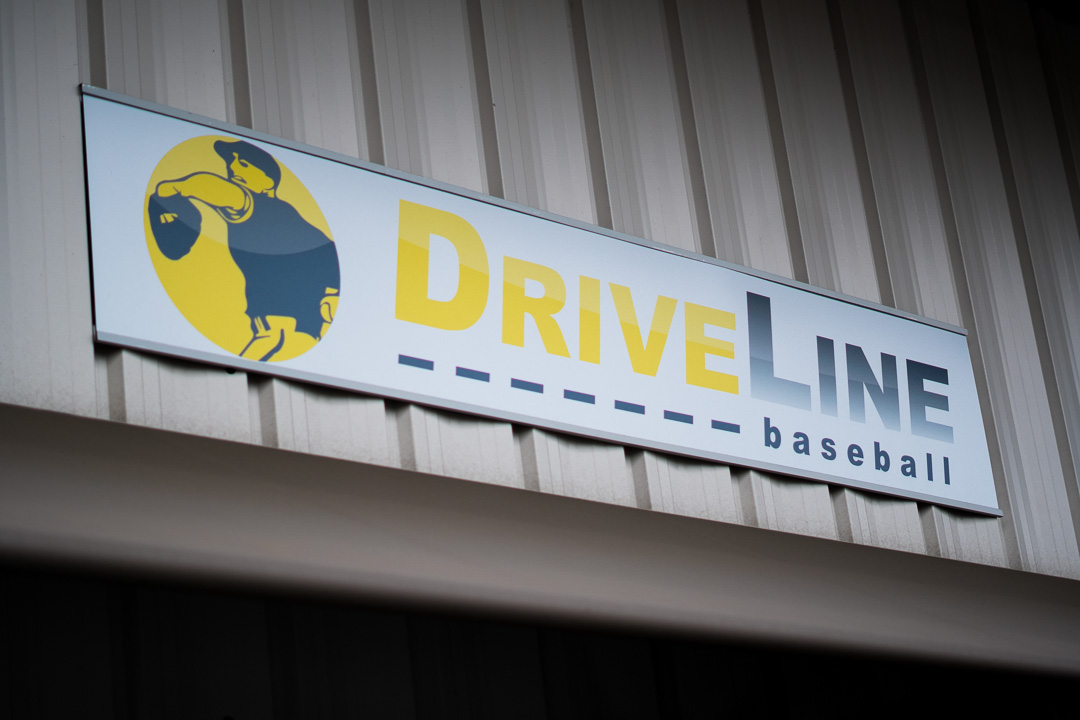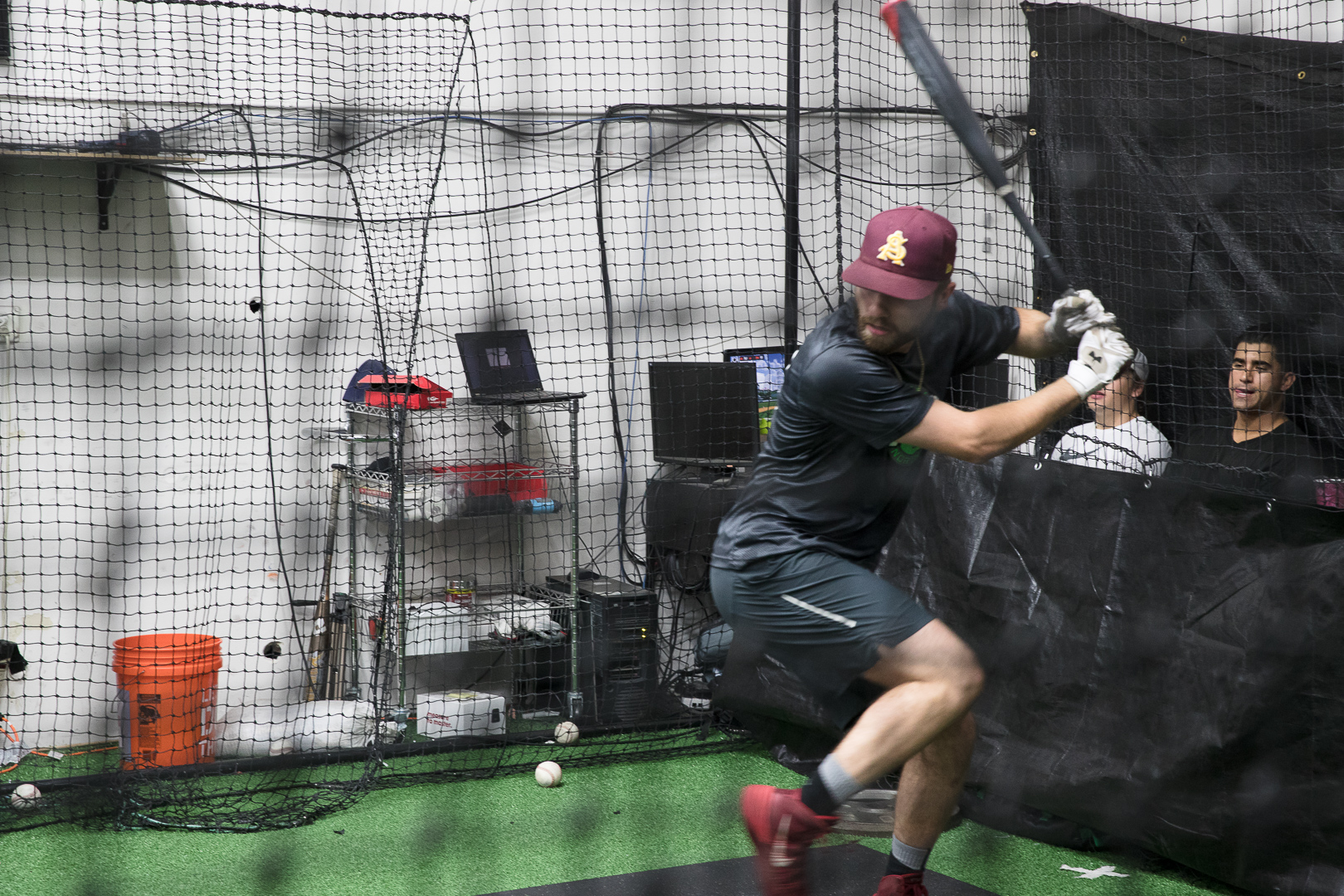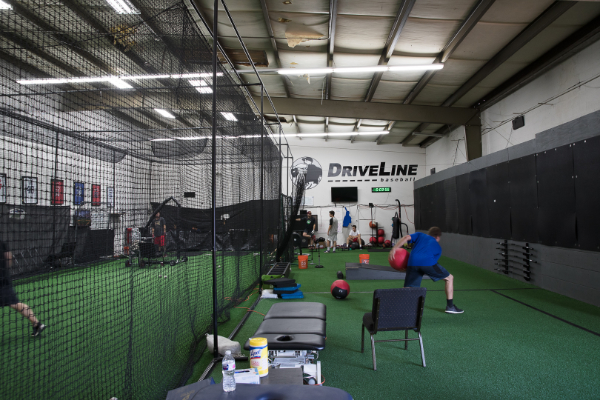The Hitting Intern Blog | Driveline Baseball Week 1

For the next 12 weeks, I will be posting a weekly update of what I am learning here at Driveline Baseball. I will be talking about my thoughts going in, and at the end of each week, I will focus on the material that I learned, observed, and/or material I discussed with trainers or trainees. I am mainly doing this so I can keep track of my progression as a coach, but I also want to do this because maybe it could spur some thoughts in you as well.
MY PERSPECTIVE WITHOUT FLIP-UPS
“Take a deep breath, park the car, get out and figure out which building to walk into.”
Those were my first thoughts on day one of my internship with Driveline. Naturally, I walked into the wrong building (well not completely wrong)—instead of the training facility, I walked into the building that houses the inventory, customer relations, and other business operations. After I was shown around that building, I walked over to building 4-3 (also known as the R&D building).
As I entered, I could hear the sound of clicks, ticks, and taps, and eight desks came into view. There were monitors everywhere, and the sound turned out to be employees crushing keys on their keyboards. It was almost as if I had been dropped into a corner of an advanced Best Buy store.
Around the corner, there are four more desks with more monitors. In the middle of the room, there is a table with just a couple monitors—it’s a utility table, and is mainly where I will be whenever I need to use my computer during the upcoming months.
In this same room, there is also a cage where they do pitch and swing design, and two squat racks and weight equipment they use for strength assessments. Naturally, there is a Plyo Ball ® wall and big screen TVs, Edgertronic cameras and force plates—not to mention, Terry Philips, the physical therapist here at Driveline, who sees athletes all day.
To say this is baseball heaven is an understatement. The culture here is absolutely remarkable. The relaxed environment that you feel at a baseball game is energized by the focus of a group of people intent on completely crushing their work responsibilities. Everyone has a role, and every role is equally important. Employees seem to expect that the person next to them is working just as hard, if not harder than they are—I am surrounded by work ethic and excellence.
The conversations that I get to listen to are just as fascinating as the room I sit in. I can hear Terry talking with athletes about their aches, pains and injuries, the strength coaches running guys through a strength assessment, and pitching trainers using Edgertronic cameras and a Rapsodo machine to work and talk with pitchers. I am surrounded by an ocean of baseball knowledge, where every employee would admit they aren’t the ocean but are all willing to explore every ounce of the water.
Failing, learning, exploring, researching, and collecting data is the norm. There is a lot of similarity between the environment here and the environments you read about in Ed Catmull’s well-known book, “Creativity Inc.”, where he describes places in which creativity, business, and leadership flow together as one.
The systems for communication here are also very effective, to the point that communication among employees and between departments seems almost flawless. There are so many moving parts at Driveline that communication is vital for its efficiency and effectiveness.
The culture here is also very welcoming. Pretty much everyone was introducing themselves to me, and they all approached knowing that I was the new “hitting intern.”
THE WALK OVER TO 2-4
This building is where the training happens, and is also the building that is famously seen on Twitter. There is one cage, a long Plyo Ball ® wall, and a corner with weights. There are TVs everywhere showing HitTrax reports and slow-motion videos of pitchers throwing.
I walked in to find a TON of players in there, training—it is complete madness! I kept telling myself: “Pay attention and keep your head on a swivel.” It was like a live version of a 6v6 round on the map “Rust” in Call of Duty: Modern Warfare 2 (and yes, that is a COD reference—if you don’t know, then you missed out on life).
Anyways, back to the environment. A ton of guys were going through their Plyo Ball ® work, right next to two guys rolling out on foam rollers. Hitters were warming up for live at-bats. Now, if you have coached anywhere where you can’t get on the field before the season, then you know what it is like to do live at-bats in a cage.
HOWEVER, let me just say, you have not experienced live at-bats until you experience Driveline live at-bats. Pitchers and pitching trainers were all lined up on one side of the cage, while the hitters and hitting trainers were on the other.
To say there is trash talking would also be the understatement of the year. This place isn’t for the weak. Pressure comes in many forms, and one part of the training here is learning how to experience and grow from the intense emotions that often arise in highly competitive environments.
Here’s one of the rules for hitters: “If you are swinging your game bat against game speed pitches—whether that’s live or off a machine— you wear Blast sensors.” If you don’t have a sensor on your bat, then you get kicked out of the cage—a sensor is just as important as a bat. During live at-bats, a hitting intern or hitting trainer tracks every pitch, location, count, the result of the action, and the results of the swing (EV, LA, bat speed, and attack angle).
BEFORE
When I started week one at Driveline Baseball, I didn’t know how to work a HitTrax machine. I had seen them at a couple of conventions and I had some knowledge of what they do, but I had never had a chance to work with or see one in a practice setting.
Tanner Stokey changed that on day one.
Within one hour of being in 2-4, Tanner was showing me how to work the basics of HitTrax. As I was watching live at-bats, I was watching John Soteropulos mash keys as he tracked outcomes. Meanwhile, Zack Jones was breaking down and explaining the culture, and how to uphold it. This culture wins, period. Players develop and get better, and learn about themselves as players and individuals. Speaking as a former college coach, this is a giant win.
***For the past three years, I have encouraged my players to go to Driveline, and 100% of the time they come back better not only in terms of skills, but also physically and mentally.
AFTER WEEK ONE
As the week wrapped up, I can confidently say that I am encouraged that I will (eventually) get the hang of this. Collin Hetzler has been a tremendous help with my learning curve, as he is helping me learn the ins and outs of my current responsibilities. I am ready for week two and the challenges it will present.
I know how to run the training floor for the hitters at the base level. What does that mean? Basically, it means I can put hitters in HitTrax, send hitters’ reports from HitTrax to our analytics team, and I can run the hitters groups. It is not much, but the one thing I don’t want to be is incompetent in this business.
My goal is to improve every day so that I can contribute to my department and this business as a whole. More importantly, I want to start helping players develop so they can reach their goals and achieve their dreams of playing this great game.
COACHING
In the coaching section, I am going to break down what I learned this week and see if I can apply it to college coaching, often reflecting on how I would implement it if I were a head coach of a college program. They might strike you as ideas that you could use to improve your program, but they might not seem relevant to your situation. Feel free to take what you like and discard the rest.
The way the hitting groups are done here is very efficient, especially if you only have one cage. If you want to replicate what Driveline Baseball does, then I think these are the bare minimum materials that will be needed:
- 1 cage with an L-screen
- 1 tee (more is obviously better)
- A set of Hitting Plyo Ball ®
- 1 Spin Ball machine (easy to maneuver)
- Baseballs (more the better for time efficiency)
- Heavy Long Bat
- Short Bat
- Axe Bat Speed Trainers
- 4 Bat Sensors
Break up your team into individual hitting groups of four. To keep it manageable in terms of time, I would limit it to 16 to 20 hitters (no more than 20). If you have a GA or student assistant, have them run the groups throughout the day. If you don’t have time to individualize each hitter’s program, then try and group your hitters into buckets according to their swing flaws.

After the 20 minutes are up, back up the machine or just crank up the velocity (a spin ball machine is lighter if you decide to move it). For the next 40 minutes, let your guys go to work. During these 40 minutes would be a good time to put the sensors on their regular bats.
This would also be a good time to have some target goals such as bat speed PRs or attack angle goals. If rounds are 8 to 12 swings, guys are going to get around 100 swings in this hour. If this is individual time, then BP during practice can be more versatile.
If time is an issue (because finding four hours outside of practice to work with hitters can be difficult), then shorten the rounds to 20 minutes instead of 40 and stagger them. A group could be hitting in a cage before practice, so when BP starts on the field that group could hit on the field for 20 minutes while the next group heads to the cage.
This setup would mean BP at practice would be about 80 minutes long and your hitters will get more purposeful swings than your typical progression from “station work” to 30 swings on the field. Programs with more resources, cages, and time could easily optimize this system, to the point that their players get better at an alarming rate.
CONCLUSION
As the week progressed, my responsibilities at the gym seemed less overwhelming, but the best way to describe my daily experience is with a baseball analogy. Imagine being a pinch hitter sent into the box with the bases loaded, two outs, and down by three. It’s an 0-2 count, everyone is counting on you to produce, and the guy on the mound is throwing 97 mph—now imagine that this feeling might never go away.
Driveline keeps me on my toes. The culture constantly encourages me to do my job extremely well in order to contribute to the company— but more importantly to the game of baseball.
By Chase Glaum
Comment section
Add a Comment
You must be logged in to post a comment.

Coach LaVoie -
Thank you for the summary. Well done and enjoy every minute!